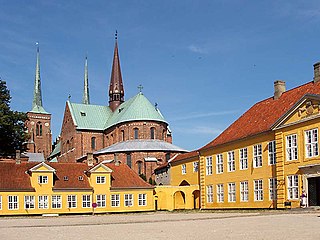
Roskilde is a city 30 km (19 mi) west of Copenhagen on the Danish island of Zealand. With a population of 52,974, the city is a business and educational centre for the region and the 10th largest city in Denmark. It is governed by the administrative council of Roskilde Municipality.

Maribo is a town in Lolland Municipality in Region Sjælland on the island of Lolland in south Denmark. It was the municipal seat of the former Maribo Municipality, until 1 January 2007, and then it became the seat of the current Lolland Municipality.

Nakskov is a market town on the island of Lolland in south Denmark. The town has a population of 12,445 and is the largest town on the island of Lolland. It is located in Lolland municipality in Region Sjælland.

Sakskøbing, previously spelled Sakskjøbing, is a town on the island of Lolland in south Denmark. It has a population of 4,556. Until 1 January 2007 it was the seat of the former Sakskøbing Municipality, and is now situated in Guldborgsund Municipality in Region Sjælland.

Falster is an island in south-eastern Denmark with an area of 486.2 km2 (187.7 sq mi) and 43,398 inhabitants as of 1 January 2010. Located in the Kattegat, Belts and Sound area, it is part of Region Zealand and is administered by Guldborgsund Municipality. Falster includes Denmark's southernmost point, Gedser Odde, near Gedser.

Lolland Municipality is a kommune on the island of Lolland in the Region Sjælland of Denmark. According to Municipal And Regional Key Figures (www.noegletal.dk) it covers a total area of 885.40 km2 and has a population of 39,632. The western part of Guldborgsund Municipality, the southernmost in Denmark, occupies the eastern part of the island (Østlolland).

Maribo Cathedral is a Lutheran cathedral church built in the Gothic style in Maribo on the island of Lolland in the southeast of Denmark. It was originally part of Maribo Abbey which was founded in the early 15th century. The chancel, the oldest section of the cathedral, probably dates from 1416. The plan of the church is unusual in that the chancel is at the west end of the building rather than the east as a result of the design instructions left by Saint Bridget.

Torkilstrup, also Torkildstrup, is a little village some 7 kilometres (4.3 mi) southeast of Nørre Alslev on the Danish island of Falster. It is best known for Torkilstrup Church, one of the island's oldest churches, built before 1160. The adjacent Torkilstrup Rectory and Torkilstrup Windmill are both on the Danish registry of protected buildings and places.
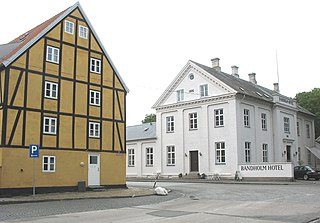
Bandholm is a small port town and parish on the coast of northern Lolland, Region Zealand, Denmark. On 1 January 2024 it had a population of 443, and is located to the northwest of Knuthenborg Safari Park and Maribo. From Bandholm there is ferry service to Askø and rail link to Maribo, 8 km (5.0 mi) north of Maribo. Stokkemarke is its west and Østofte Parish forms its southwest border. It is served by Bandholm Station. The Maribo-to-Bandholm rail branch is operated by the Museumsbanen Maribo-Bandholm as a preserved railway.
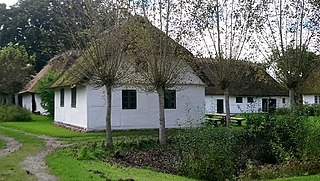
Maribo Open-Air Museum is a museum located on the western outskirts of Maribo on the Danish island of Lolland. It is located 1 kilometre (0.62 mi) from Torvet, to the west of the Maribo Sø Camping site and oak woodland, near the northern banks of Søndersø Lake. It is the third oldest open-air museum in Denmark, and is in the backdrop of the Maribo Lakes Nature Park. Located on Meinckesvej, Maribo, the museum is open to visitors from 1 May to 30 September every day except Monday from 10 am to 4 pm.

Nørreballe is a village on the Danish island of Lolland. With a population of 476, it is located 6 km (3.7 mi) northwest of Maribo. The village of Østofte with its 14th-century Østofte Church is now part of Nørreballe.

Østofte Church, located in the village of Nørreballe on the Danish island of Lolland, was built in the 14th century. The Romanesque apse, chancel and nave formed the original building while the tower and porch were added in the Late-Gothic period and the north wing was completed in 1656.
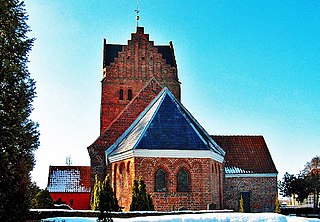
Stokkemarke Church is located in the village of Stokkemarke some 11 km (6.8 mi) northwest of Maribo on the Danish island of Lolland. Dating from the middle of the 13th century it was built in the Romanesque style with later additions in the Gothic period.

Hunseby Church is located in the village of Hunseby some 3 km north of Maribo on the Danish island of Lolland. Built in the middle of the 12th century, the church has a Romanesque chancel and nave and a Gothic tower.

Hunseby is a village located some 3 km (1.9 mi) north of Maribo on the Danish island of Lolland. It belongs to Lolland Municipality in Region Sjælland. As of 2024, it has a population of 399.

Sandby is a village located some 7 km (4.3 mi) northwest of Nakskov on the Danish island of Lolland. It belongs to Lolland Municipality in Region Sjælland. As of 2024, it has a population of 348.

Halsted Church stands in the little village of Halsted some 6 km east of Nakskov on the Danish island of Lolland. Dating from the second half of the 12th century, the church has a Romanesque chancel and nave, a large burial chapel from 1636 and a tower from 1877. The church was closely associated with Halsted Priory, which has not survived.

Nakskov Church is the largest church in Nakskov on the west coast of the Danish island of Lolland. As Nakskov was mentioned in Valdemar's Census Book in the 13th century, the church probably dates to the same period.

Birket Church is located south of the little village of Birket, some 14 km (8.7 mi) northeast of Nakskov on the Danish island of Lolland. Its chancel was originally the nave of the brick Gothic church built in 1350. The bell tower, which stands apart from the church, is believed to be Denmark's oldest standing wooden structure.
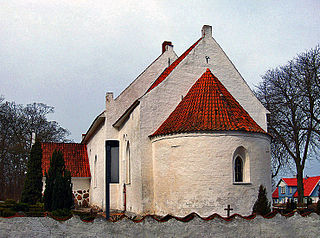
Arninge Church is a Late Romanesque church in the little village of Arninge, some 8 km (5.0 mi) south of Nakskov on the Danish island of Lolland. Built of red brick in the 13th century, it has an intricately carved auricular altarpiece created by Henrik Werner in 1644.



















